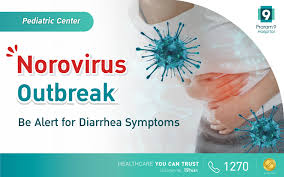Norovirus outbreaks can occur at any time, but they are typically more frequent in the winter months. The virus is most prevalent from December to April, and many outbreaks occur during the winter months. Although it can spread throughout the year, it is most active during the winter months.

When and why does norovirus spread?
- More spread in the winter months: Norovirus is more active during the fall and winter months. This is mainly because people spend more time indoors at this time and there is more physical contact. This increases the likelihood of the virus spreading. For example, schools, hospitals, cruise ships, and other public places that are more crowded are where norovirus spreads.
- Rapid spread: Norovirus is a highly contagious virus. It can spread from person to person very quickly, especially when an infected person has contact with other people. The virus can also be contracted through contaminated surfaces, food, water, or air. This means that if one person is infected, he or she can easily infect others.
- Outbreaks in crowded places: Cruise ships, hospitals, schools, and other public places where there are large numbers of people are more likely to cause norovirus infection. In crowded places, people come into contact with each other, which makes the virus spread quickly. Lack of hygiene and unhygienic environments in these types of places can also cause outbreaks.
- Decreased immune systems: Some individuals may have weakened immune systems, such as older people, children, and people who are sick. These individuals may have more severe norovirus symptoms, and may also be at increased risk of infection. For this reason, outbreaks are more common in certain places, such as nursing homes, hospitals, and children’s schools, where it spreads rapidly between individuals.
- Seasonal pattern of infection: Scientists believe that norovirus outbreaks follow a seasonal pattern, with more activity during the winter. Although the virus can be active year-round, the infection is more prevalent during the winter months, as people spend more time indoors, where there are more opportunities for the virus to spread.
What causes norovirus to spread?

- Contaminated food and water: Norovirus is often spread through contaminated food and water. Sea creatures, such as shrimp, snails, and fish, may contain the virus if they come from unhygienic water. Also, water can be a source of the virus if it is contaminated.
- Contact with contaminated surfaces: The virus can survive on surfaces for a long time. If a person touches an infected surface, such as a table, doorknob, utensils, or bathroom items, he or she may get the virus on his or her hands and later become infected by touching his or her mouth or face.
- Contact with an infected person: If someone is infected with norovirus, the virus may be transmitted through vomit, diarrhea, or saliva. This virus can spread in the air as soon as it comes out of the person’s body or fall on infected surfaces, putting other people at risk of infection.
- Infection spread rate: The biggest feature of norovirus is that it is highly contagious. This virus can cause infection even in small quantities. As soon as the infected person comes in contact with another person, the virus spreads very quickly.
Conclusion
Norovirus outbreaks usually occur more in winter, because at this time people spend more time indoors and come in contact with other people. This virus can spread through various sources of infection, such as contaminated food, water, and infected surfaces. The spread of this virus is extremely fast, due to which it is important to pay special attention to preventive measures. The outbreak of this virus can be controlled by washing hands, maintaining cleanliness, and avoiding infected persons.